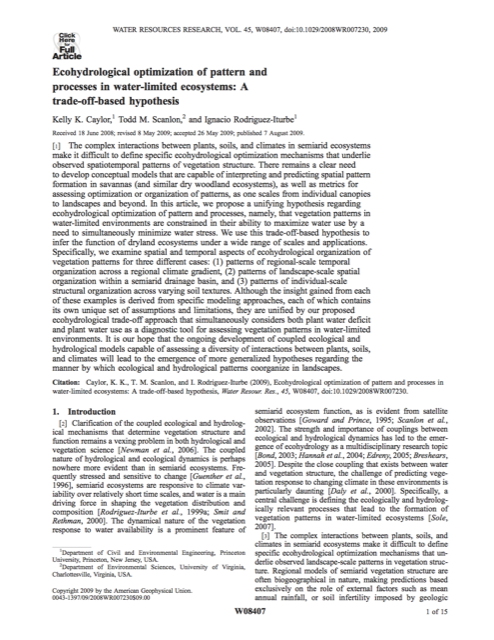Ecohydrological optimization of pattern and processes in water-limited ecosystems: A tradeoff-based hypothesis

Caylor, K.K., T.M. Scanlon, I. Rodriguez-Iturbge (2009) “Ecohydrological optimization of pattern and processes in water-limited ecosystems: A tradeoff-based hypothesis,” Water Resources Research, 45, W08407, doi:10.1029/2008WR007230.
The complex interactions between plants, soils, and climates in semiarid ecosystems make it difficult to define specific ecohydrological optimization mechanisms that underlie observed spatiotemporal patterns of vegetation structure. There remains a clear need to develop conceptual models that are capable of interpreting and predicting spatial pattern formation in savannas (and similar dry woodland ecosystems), as well as metrics for assessing optimization or organization of patterns, as one scales from individual canopies to landscapes and beyond.
In this article, we propose a unifying hypothesis regarding ecohydrological optimization of pattern and processes, namely, that vegetation patterns in water-limited environments are constrained in their ability to maximize water use by a need to simultaneously minimize water stress. We use this trade-off-based hypothesis to infer the function of dryland ecosystems under a wide range of scales and applications. Specifically, we examine spatial and temporal aspects of ecohydrological organization of vegetation patterns for three different cases: (1) patterns of regional-scale temporal organization across a regional climate gradient, (2) patterns of landscape-scale spatial organization within a semiarid drainage basin, and (3) patterns of individual-scale structural organization across varying soil textures.
Although the insight gained from each of these examples is derived from specific modeling approaches, each of which contains its own unique set of assumptions and limitations, they are unified by our proposed ecohydrological trade-off approach that simultaneously considers both plant water deficit and plant water use as a diagnostic tool for assessing vegetation patterns in water-limited environments. It is our hope that the ongoing development of coupled ecological and hydrological models capable of assessing a diversity of interactions between plants, soils, and climates will lead to the emergence of more generalized hypotheses regarding the manner by which ecological and hydrological patterns coorganize in landscapes.
